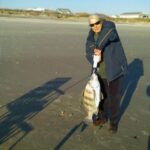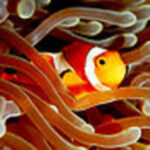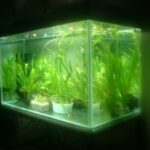Bonito usually show up when water temperatures rise above 70 degrees, they migrate up from Mexico. Buy a copy of Western Outdoor News, a So. Cal. fishing and hunting newspaper, then read the saltwater section, you will see where the bonito are being caught. Either take your boat there or wait until they come to your area.
Say they have been caught in your area, launch your boat and get yourself a scoop of live bait. Now go looking for birds, if you cannot find any birdpiles look for an area where birds are sitting on the water, the more birds the better. Birds don’t just hang out for no apparent reason, if they are there in numbers, there is food nearby and soon predatory fish will chase them to the roof ( surface )
If the water is less than 100 ft deep, you can drop live bait down to the bottom where you may catch halibut or sand bass, or, you may just want to cast 2 oz. chrome crocodile spoon made by Lur Jensen. This spoon will catch almost all of So. Cal’s game fish including all the tuna. If the tuna are the larger grade you may want to upgrade to a 4 or 5 oz spoon.
When I am prospecting for bonito, I usually cast the “croc” out as far as I can towards where the birds are sitting, then with the reel in gear I let it sink on a tight line till it hits the bottom. Sometimes you get hit on the sink sometimes when you are reeling in the lure, in any case as soon as someone gets a fish a hand full of chunks and a few live bait should be thrown in the water behind the boat.
If the fish is a bonito his friends are usually right behind him, as soon as you see it is a bonito, throw a hand full of live chum behind the boat. If his friends are near they will usually start crashing the chum, grab your fly rod and cast a fly to the crashing fish, usually the hookup is instant. I keep throwing 5 or 6 chums per minute until the school leaves or stops crashing the chum. Then I start casting the crocs again until I get a hookup or 20 minutes goes by, then I start looking for a new group of birds. And start the whole process again.
No birds no problem! If you can’t find any birds you can still find bonito, there are a few simple steps to finding fish most days, even if you do not see any birdpiles. First find out where the bones were the last few days, check the fish counts of your local partyboats, check with friends to see where they have been catching bones, or go to areas where you have caught them in the past.
If bonito have been caught recently in an area, I may start out trolling a small tuna feather about 4 inches long, I usually troll about 6 to 8 mph when I’m searching for fish, and run my lures 30 to 40 feet behind the boat. Trolling in a slow “S” pattern is better than trolling in a straight line. I always have someone on the binos looking out at distance.
If I see a kelp paddy, I troll by it from several directions, if there are lots of paddys I usually only make one pass. If there are only a few I make three or four passes and throw some live chum on them as I go past. Keep an eye out for boils on the chum as that may indicate bones are present.
I keep the fly rods sitting in the corner of the rail so they will be handy when we get a trolling hookup. When a fish hits the feather, immediately throw a handful of chum and cast your fly out behind the boat and strip it in fast. If fish start boiling in the chum, keep throwing chum a few at a time to keep them around the boat.
If no fish are located trolling, I usually look for a partyboat and anchor about 200 feet behind him ( don’t get too close, always give anchored fishing boats space to fish in ) Party boats usually throw lots of chum and it will come down current towards you, this can get bones in a chewing mood if they are in the area. If no bonito are to be found, all is not lost, there are plenty of other fish species that will hit the flys, calico and sand bass, mackerel, halibut ( sinking line in shallow water ) yellowtail, white sea bass, and many others. I have caught all these and more on the fly here in Southern California.







